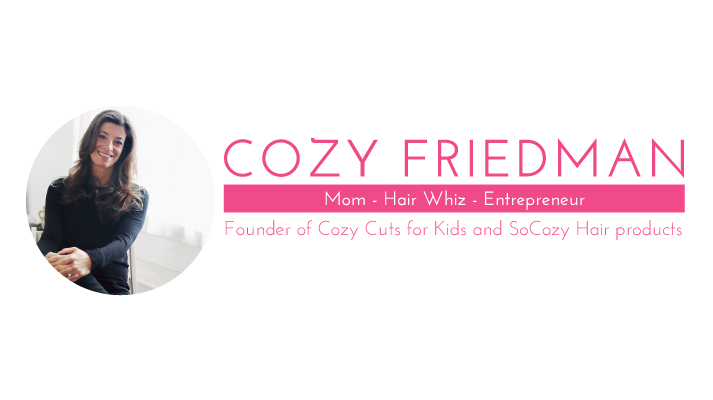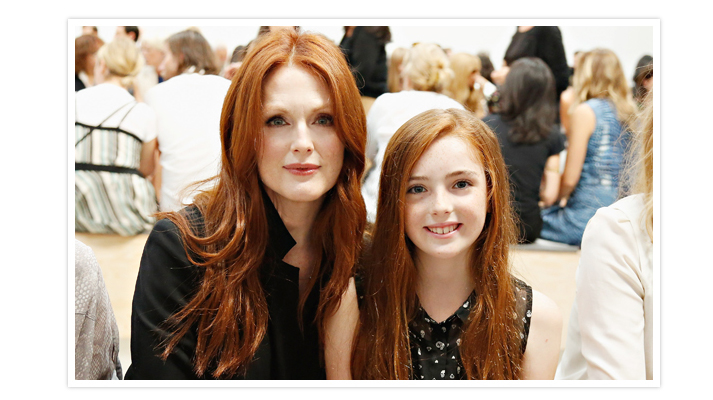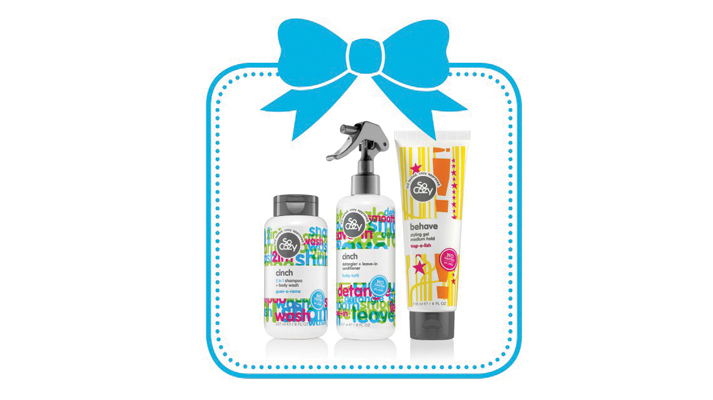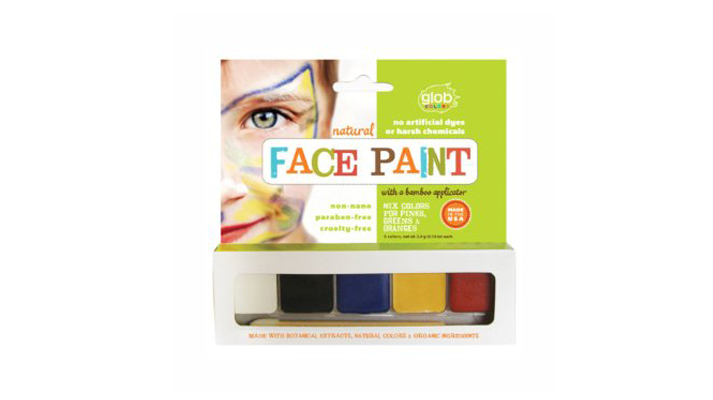

Twenty years ago, Cozy Friedman pioneered the first children’s hair salon in New York City. Part play space, part toy store, Cozy Cuts for Kids is a institution—a rite of passage for a first haircut, a destination for boys and girls to get regularly coiffed while watching their favorite movie. For little ones, there are toy cars, planes and butterflies to sit in, Elmo videos and bubbles— turning a haircut into happy hour. For bigger kids, there are kid-sized salon chairs, countless videos to choose from and a wall of dazzling hair accessories that makes girls swoon. A saunter through the toy aisles might make a haircut cost a little bit more, but believe me, it’s all worth it. And the whole experience is topped off with lollipops and balloons. A visit to Cozy’s is so fun, they do birthday parties.
There is no higher expert on kids’ hair than Cozy Friedman. Last year, she launched SoCozy haircare for kids because she realized there was a huge gap between baby hair care and adult products. And it’s so true. That’s why I was still using “baby” shampoo and conditioner on my seven year-old. As with her brilliant salon idea, Cozy answered another obvious need in the world of kids hair. And if, like me, you’ve ever had to detangle a little girl’s hair while she screams, or attempted to calm down a boy’s morning bed head before school, you, too, realize that the world of kids hair is not to be taken lightly.
Kids Hair Really Is Different
”They” say that a person’s hair texture changes every 7 years and I’m a believer that it’s true. However, baby hair is different than toddler hair which is different from older kid’s hair. It’s not a particular age though that the texture changes. I see kids in my salons that need a haircut at 5 months, whereas some kids don’t need a haircut before turning 4. Every child is different.
That’s Why SoCozy Hair Care Has “No-Nasties”
Definitely, which is the reason why it’s so important to choose products that are specially formulated for kids. Watch out for harmful ingredients. With a little effort, it’s possible to find substitutions that deliver professional results so we’ve made that commitment. We have a non-negotiable No Nasties policy for our formulas and we’ve even taken that a step further to include no gluten, nuts or wheat.
On Getting Kids To Wash Their Own Hair
The hardest part of getting children into washing their own hair is making it not feel like a chore. Make it a fun activity and be prepared for mishaps. Shampoo will inevitably drip down into their face so keep a wash cloth handy before it drips too much and be sure to use tear-free formulations. In my salons and with my own kids, I’ve noticed that if kids love the fragrance they will actually want to wash their hair.
Different Hair Types, Different Wash Schedules
• Out of control frizz: Wash every three to four days to let natural oils build to combat the frizz. Using a hydrating conditioner after you wash keeps hair moisturized and frizz free. Our SoCozy Super Hydrating Conditioner gets the job done in a snap.
• Flat flyaways: Wash hair very two to three days and use a quality shampoo and conditioner such as the SoCozy Cinch 2-in-1 or 3-in-1. You want to make sure you don’t weigh hair down with heavy conditioners in an effort to manage the flyaways.
• Lice: No one likes to talk about it but lice happens. Many parents don’t realize they can take preventative steps to avoid the pesky critters. Don’t wash your kid’s hair every day. A buildup of natural oils make it harder for lice to attach to the hair shaft. Another tip is to use tea tree oil-based products like SoCozy Boo! Lice Prevention Shampoo and Spray. Use shampoo every other day, and use spray regularly on hair, pillowcases, hoods and hats.
The Key to Tear-Free Tangles
Use a wide-tooth comb and not a brush. For long hair is really important to section hair with clips and spray a detangler while combing. Our Cinch Detangler + Leave-In Conditioner was created specifically with knots and bedhead in mind.
The Right Brush Helps, Too
I just created a brush for SoCozy (launching soon) that has soft padding and coated bristles that’s really gentle and amazing for getting out tangles- which is what it’s all about for kids! Knots and tangles are a big issue so I created the perfect brush with coated bristles and soft padding to make process fast and tear-free – which is what it’s all about with kids.
Boys Have Hair Issues, Too
It’s bedhead. We’ve all seen little boys with crazy bedhead in the morning but it’s an easy problem to solve and it doesn’t take much time at all. For wavy or curly hair I recommend a leave-in conditioner. Just a couple spritzes will calm crazy hair and help re-establish the curl. For fine or straight hair, a light styling cream is all you need to put hair in its place and give a natural hold.
Happy curls = Happy Girls
Of course just like most women girls with curly hair wish it were straight. The trick is learning how to manage the curls without creating frizz. I suggest parents take the time to understand curly hair and teach their daughter how to embrace her curls, rather than trying to disguise them by blowing hair straight. I have really curly hair, and when I was growing up, no one ever told me that you’re not supposed to brush curly hair, because it turns into a giant “frizzball.” Take the time to learn what works and what doesn’t work for your child, everyone will be happy!
Why Kids Look Pretty Normal These Days
Hair trends are pretty traditional at the moment. For girls it’s the fishtail braid and for boys the perfect gentleman’s part. Both are simple and take very little time to do! We have lots of how-to videos that give parents an arsenal of quick and easy hair styles.
Want to learn how to give your daughter a Mermaid Flip Tail or give your son a “Gentleman’s Part?” Check out Cozy’s great how-to video’s and her book, Cozy’s Complete Guide to Girls Hair that’s a complete reference guide for everything from fancy up do’s to everyday favorites.

The other day my two year old went into the coat closet, took out a floral raincoat and proceeded to have a full-body struggle to get it on. She didn’t know I was peeking at her through the door. I watched her scan her coats—from a navy lightweight down jacket, through colorful vests, to the thick padded polka dot number with a furry hood that would have been the appropriate choice for the arctic weather.
She came running to me, arms up in the air with a giant grin on her face—clearly so proud of not only her self-dressing accomplishment, but of her particular choice of coat.
If I hadn’t just finished reading Tovah Klein’s eye-opening book How Toddler’s Thrive:What Parents Can Do Today for Children Ages 2-5 to Plant the Seeds of Lifelong Success, after praising her for getting it on, I would have gently explained that the raincoat wasn’t the right jacket for the day and helped her change.
But I let her wear the raincoat.
I just layered a warm vest over it. I didn’t worry about being judged as a mother for improperly dressing her toddler in NYC in the heart of winter. I didn’t worry that my daughter looked a little kooky and mismatched. Why? Because I had just validated my toddler in a very big way. And she felt great about herself. She showed her jacket to her teachers in class and she kept it on, with pride, all day.
Helping our children feel good about themselves is the foundation for their success in so many ways. We use the word confidence so freely—we want our kids to feel “confident.” But what does real confidence look like?
Hint: it has nothing to do with looks.
In her book,Tovah Klein gets to the heart of confidence building—and it starts early. Before the age of two. Backed by science and 25 years as the director of the Barnard Center for Toddler Development, Klein, an associate professor of psychology (and a developmental advisor for Sesame Street) gives an eye-opening look into the world from your child’s perspective and how you can harness that vantage point to be a better parent and build lasting self-esteem.
I was thrilled to be able to talk to Tovah about these issues so close to the heart of BeautyMama’s mission. I gained some invaluable tools on how to help my girls feel good about themselves—in a lasting, core way. And that makes me feel good.
Who is that toddler in the mirror?
Children first develop a sense of self around 15-18 months. This is usually when they start saying “no” a lot. They start demanding no diaper change. They start realizing, ‘Hey, I’m my own person’ but it’s not fully formed. By 2-3, they have a stronger sense that they’re a person separate from Mom and Dad and that they have their own ideas.
Why You Shouldn’t Worry If Your Two-Year Old Wants to Wear the Same Blue Shirt Everyday
When kids start realizing they have their own ideas, it can come off as controlling. They’re realizing they can want something different than what you want. I’m my own person and I only want blue pants today. It’s not linked with a social consciousness at this point, they’re really figuring out who am I and what do I want? That initial who am I comes with separation and is supported by the parents—“You want blue pants today? Cool. Because I value you for you.” I can always tell the children who dress themselves because it makes them feel good, as in, “I picked this. This is me.”
By giving them confidence in their decision making and desires, we are instilling in them a sense that they’re O.K….so that on a not so great day when they’re melting down and you’re not having a great parenting day, you can say, “That was a rough day. Mommy yelled and you were so upset…and I still love you.” That’s where they get a sense that they’re going to be alright in the world. So the clothing choice— it’s not a focus on their looks, it’s really about something else.
Why You Should Practice Roaring Like a Lion In Front Of the Mirror With Your Toddler
Our whole center, where we have toddler classes has mirrors (because it’s a one-way observation mirror) and the children practice faces and emotions for fun all the time…they’re really trying it on in terms of learning their emotions. The feedback they get is, all of that is me. That happy, sad, or ferocious face— you can be all these things and that’s who you are.. There’s a lot of practicing and mimicry. Thats the first step of getting to know “me.”
Don’t Panic If Your Son Wants To Wear Nail Polish
One of my children went through a period where he would put makeup on with me in the morning. Most people think it’s a girl thing, but he didn’t know that. He would want nail polish and his favorite color was, still is, blue, so he had blue nail polish. (Until he got all the messages from other people that boys don’t wear nail polish.) Kids like to live in the adult world. Little girls really like to put on makeup because that’s what the adults of their sex do. I think if you battle children, and you say no, no, no, you can’t wear nail polish, and they’re looking around and seeing people wearing nail polish, they wonder why it’s being banned. It becomes even more interesting. They imitate us. They’ll paint their nails with magic markers, girls and boys. Kids are practicing to be grownups all the time—when they try to sweep with a broom or carry a briefcase and “go to work.” If you see it all in this context, it’s not such a negative thing.
‘Pretty’ is only part of it
We all want for our children to grow up confident in who they are, and who they are is a complex being—there’s what they think about, their range of emotions, their desires—and physical appearance is a part that. We live in a very physically orientated world, right or wrong. I’m not saying it’s right for sure. What we can really do is help our children feel good no matter who they are, what they feel, or what they look like. And you do that by loving them in all their complexity. Looks are just a part of it. When we tell our children all of the things we love them for—I love you because you’re funny, I love you because you cry sometimes, I love you because you love to do math, when you put your favorite dress on—you’re saying these are all parts of you and I love all of them.
Why Loving Kids When They’re Bad Is Good
Children are “bad” sometimes, and their biggest fear is being “found out.” What if you find out that I really hated you today when I was so angry when I had to be quiet….would you still love me? What I see and what concerns me—is children being ashamed of what they’re feeling. For example, even something as simple as “You don’t need to cry when I take you to school,” really says to the child, it’s not okay that you feel that way. Kids are so fragile and undeveloped at this age, they have so many feelings…and you want them to feel ok no matter what they feel. To understand, I can’t necessarily hit you…but I can feel like I want to—I can own that feeling and have it. Their emotional life is so fragile at this age…. we need to respect that they’re really very little and need us to accept their full range of behaviors and feelings. Giving them the base that says, I get that you’re good sometimes, I get that you’re bad sometimes, you’re happy sometimes, you’re sad sometimes—and I love you for all of it is really where there base comes from. Helping them feel like, Hey, I’m okay in the world.
Pretty Is As Pretty Does
When parents are approaching a child telling them how beautiful and pretty they are– and then how un-pretty they are when they’re wearing outfits they don’t like or when they didn’t take a bath, they get very clear messages that in order to be loved or accepted, they need to be beautiful. I think it’s different when it comes from the child—when they’re putting on dress up clothes and ask “Am I beautiful in this?” and the parent smiles and says “sure you are.” If beauty is emphasized in your house as being important, or there’s a lot of focus on clothing, it’s going to be picked up by children.
What To Say When Your Daughter Hates Her Hair
It’s probably because she feels different. For example, ringlet curls are touched and commented upon. When a child gets undo attention for something that’s different or highly noticeable, even if it’s positive, they can get very self conscious. All of my children happen to have blue eyes and very long lashes. One day one of my sons said to me, “I don’t like my eyes.” It wasn’t that he really didn’t like his eyes. He didn’t like the attention. You might say, “Not everyone has curly hair and so I can see that you don’t want that attention, but some people think curly hair is beautiful.” You can also let her know that you think her hair is beautiful.
Let Them Eat Cake
Food, diet, being thin…we tend to over talk these things out of our own anxieties. For example, if you were a fat kid and now you have a chubby three year old and you’re worried that they’re going to be a fat teenager, you may be putting messages out there… as opposed to just serving some good foods, knowing that kids go through phases where they sometimes eat more, sometimes eat less. Sometimes they’re heavier, sometimes they’re not. Kids don’t naturally know thin is in and fat is out. The issue of body size and weight—if very young children are conscious of it, it’s coming from the home and what they hear or see around them, such as ads. If there’s a lot of talk about food, a lot of talk about dieting, being fat, that’s going to make children very conscious of it in a way they would not be if it wasn’t being talked about.
Sticks and Stones May Break My Bones—But Billboards Can’t Hurt Me
The main thing is in these early years is that parents can have a really positive influence on their children and you do that by truly for loving them for who they are and not trying to make them be something else. If you have that kid who only wants to play with trains all day long and you keep telling other people you’re frustrated that he only wants to do the same thing all the time, that’s what the child hears and he starts to feel bad for having this desire. We’re kind of in a hyper-anxiety parenting world right now—but if we can relax a little bit and really let children know they’re being loved for who they are, they’re going to have a firm base and they will need that base to get through the peer pressure and billboard pressures that come throughout their life. If what they’re getting at home—what they’re seeing, what they’re feeling— is really counter to the billboards and outside messaging, if they feel like, I’m accepted at home for who I am, that is what counts. It can’t take away the influence of billboards, but it will greatly minimize the influence.
Tovah Klein’s book may be purchased here on Amazon.
I’m also giving away copies of How Toddlers Thrive on my Facebook page.

Apparently, Julia looks just like me.
We hear it almost everyday. It comes in different ways.
“Do you know you look just like your Mommy?” A stranger might ask Julia sweetly on the bus.
“Wow. She’s your twin.” We hear a lot.
“You’re so pretty. Just like your Mommy!” We get this one from sweet grandmas, as well as creepy men on the street. Read more

My daughter, Julia, 7, all of a sudden has my head of hair. It’s thick, it’s wavy. It responds unfavorably to humidity. (Sorry sweetie.) And yet, it’s still little-girl hair, with a beautiful softness and sheen that sometimes takes my breath away. It seems like overnight, Julia needs actual “hair care.” She needs real cleansing, hydration and, I don’t know, I feel like I want to nourish her scalp with vitamin oils or something.
Enter So Cozy hair care for children. Children. Not babies. This genius line of hair products is for kids and tweens—because they’ve outgrown baby washes but are too young to borrow your shampoo and conditioner. The scents are age appropriate (read: delicious) but not babyish. The packaging is so fun and kids (both boys and girls) feel cool having products that look and feel like their very own.
The Cinch line of shampoo and conditioner offers a 2-in-1 shampoo and body wash, a 3-in-1 that is shampoo, body wash and conditioner, a hydrating conditioner and an excellent detangler/leave-in conditioner we can’t live without. The Behave line of styling products offers a gel, mousse and smoothing cream. All products are toxin free and vegan, of course. And they really work.
Check out the entire line at SoCozy.com.

One of my best mom friends recently told me that face paint had to be banned from her child’s summer camp because so many kids got terrible rashes. So, of course, I had to track down a safe alternative. And just in time for Halloween.
Glob Colors face paint is made with all natural and organic ingredients. No synthetic dyes, parabens or titanium dioxide. Even the packaging is sustainable and the applicator is made of bamboo.
Glob Colors also has a line of natural and eco-friendly art supplies you can check out here.
Love it!

1 in 133 Americans suffer from celiac disease, an auto-immune condition that renders a person unable to digest gluten, a protein found in certain grains. It’s only about 1% of the population, but I would guess it would be much more given the gluten-free food craze, don’t you think?
In response to the gluten-free demand, a few skincare brands have come out with gluten-free version of everything from shampoo and conditioner to face scrubs and lotions. I did a fair amount of research on this and was surprised to learn how many common skincare ingredients contain gluten, beyond the obvious wheat germ and oats. For example, some versions of vitamin E are extracted from wheat germ oil.
While the jury is still out as to whether people with celiac disease really need to avoid gluten on the outside of their bodies, you really can’t go wrong with this lovely line from JĀSÖN. In addition to being certified gluten-free by the Gluten-Free Certification Organization (“GFCO”), it is also chock full of certified organic ingredients like vitamin E, avocado oil and calendula xxtract. To boot, it is free of all parabens, phthalates, petrolatum and artificial colors—like all their products are— I’m a long-time JĀSÖN fan and use a bunch of their products.
This summer, I have been using the body wash and lotion on myself and my kids and really love it. It’s gentle but effective, with no fragrance.
What do you think of gluten-free skincare?